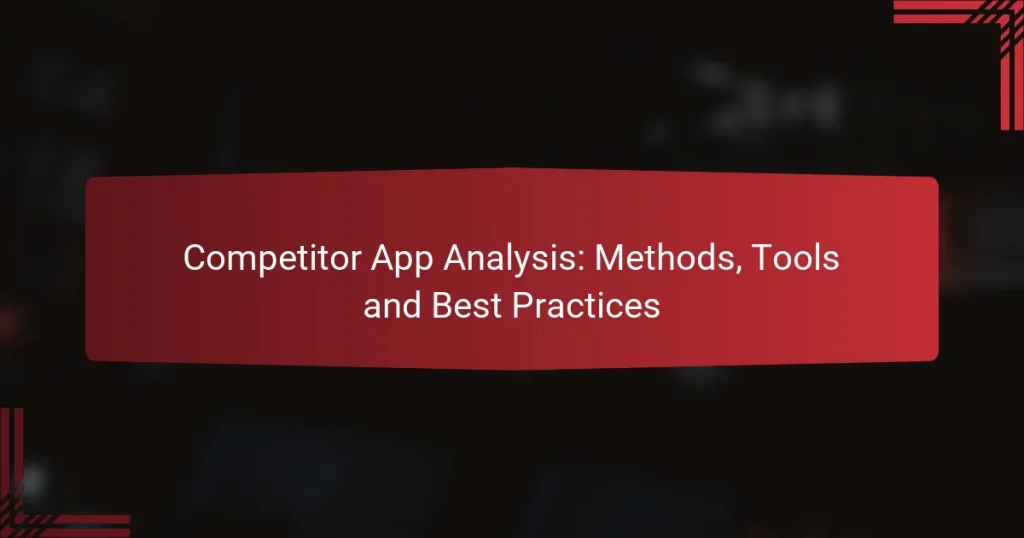Competitive analysis in app store optimization is crucial for understanding your app’s market position and enhancing its visibility. By identifying key competitors and analyzing their strategies, you can uncover valuable insights that lead to improved user engagement and performance. Utilizing specialized tools like Sensor Tower and App Annie allows for a deeper examination of metrics such as keyword rankings and conversion rates, ultimately guiding your optimization efforts.
Benchmarking: Industry Standards, Metrics and Performance
Market Gaps: Identification, Research and Opportunities
SWOT Analysis: Strengths, Weaknesses, Opportunities and Threats
ASO Strategies: Comparison, Insights and Competitive Edge
Competitor App Performance: Monitoring Tools, Metrics and Insights
Competitor App Analysis: Methods, Tools and Best Practices
How to conduct competitive analysis in app store optimization?
Conducting competitive analysis in app store optimization involves identifying your main competitors, examining their performance, and understanding their strategies. This process helps you uncover opportunities to improve your app’s visibility and user engagement.
Identify key competitors
Start by pinpointing the top competitors in your app category. Look for apps that rank highly for the same keywords or target audience. Tools like App Annie or Sensor Tower can help you identify these competitors based on download metrics and user demographics.
Consider both direct competitors (apps that offer similar functionality) and indirect competitors (apps that fulfill the same user need in different ways). This broader view can reveal unique strategies that you might adopt.
Analyze app store rankings
Examine the app store rankings of your competitors to understand their visibility. Track their positions for relevant keywords and observe any fluctuations over time. This analysis can highlight which keywords are driving traffic and which are less effective.
Utilize tools such as Mobile Action or App Radar to gather data on ranking trends. Aim to identify patterns that correlate with updates or marketing campaigns, as these insights can inform your own optimization efforts.
Evaluate user reviews and ratings
User reviews and ratings provide valuable insights into what users appreciate or dislike about competitor apps. Analyze both positive and negative feedback to identify common themes. This can help you understand user expectations and pain points.
Pay attention to the volume of reviews as well; a high number of reviews can indicate a strong user base. Consider creating a summary of key takeaways from user feedback to guide your app’s feature development and marketing messaging.
Examine app features and updates
Investigate the features offered by your competitors and how often they update their apps. Note any unique functionalities that set them apart and consider whether similar features could enhance your app’s appeal.
Regular updates often indicate active development and responsiveness to user feedback. Keep track of the frequency and nature of these updates to gauge the competitive landscape and adjust your own update strategy accordingly.
Assess marketing strategies
Analyze the marketing strategies employed by your competitors, including their social media presence, advertising campaigns, and promotional tactics. Look for patterns in their messaging and user engagement to identify effective approaches.
Consider how they leverage app store optimization techniques, such as keyword usage in their app descriptions and promotional materials. This can provide ideas for enhancing your own marketing efforts and improving your app’s discoverability.
What tools are best for app store competitive analysis?
Several tools are essential for effective app store competitive analysis, each offering unique features and insights. The best options include Sensor Tower, App Annie, Mobile Action, and Apptopia, which help you track competitors, analyze keywords, and optimize your app’s visibility.
Sensor Tower
Sensor Tower is a powerful tool for app store optimization that provides insights into app performance, keyword rankings, and competitor strategies. It allows users to analyze download estimates, revenue projections, and user reviews, giving a comprehensive view of market trends.
When using Sensor Tower, focus on its keyword research capabilities to identify high-traffic terms relevant to your app. This can help you refine your app’s metadata and improve its ranking in search results.
App Annie
App Annie offers detailed analytics and market intelligence for app developers and marketers. It provides insights into app performance metrics, user demographics, and market trends, helping you understand your app’s position relative to competitors.
Utilize App Annie’s benchmarking features to compare your app’s performance against similar apps in your category. This can guide your strategy in areas like pricing, marketing, and feature development.
Mobile Action
Mobile Action focuses on app store optimization and marketing intelligence, providing tools for keyword tracking, competitor analysis, and market insights. Its user-friendly interface makes it easy to navigate and extract valuable data.
Leverage Mobile Action’s ASO tools to optimize your app’s title and description based on competitive keyword analysis. This can significantly enhance your app’s visibility and attract more downloads.
Apptopia
Apptopia specializes in app market data and insights, offering competitive intelligence and performance metrics. It provides access to download estimates, revenue data, and user engagement statistics, which are crucial for strategic planning.
When using Apptopia, focus on its market intelligence reports to identify emerging trends and opportunities within your app’s niche. This can help you stay ahead of competitors and adapt your strategy accordingly.
What metrics should be analyzed in app store optimization?
Key metrics for app store optimization (ASO) include keyword rankings, conversion rates, download trends, and user engagement metrics. Analyzing these metrics helps identify strengths and weaknesses in your app’s visibility and performance in app stores.
Keyword rankings
Keyword rankings indicate how well your app performs for specific search terms in app stores. Monitoring these rankings helps you understand which keywords drive traffic and which need improvement. Aim for a mix of high-volume and long-tail keywords to maximize reach.
Regularly update your keyword strategy based on performance data. Tools like App Annie or Sensor Tower can provide insights into keyword effectiveness and competition. Adjust your app title and description to enhance visibility for the most relevant keywords.
Conversion rates
Conversion rates measure the percentage of users who download your app after viewing its store page. A high conversion rate indicates effective app presentation, while a low rate suggests that changes may be needed in visuals or descriptions. Aim for conversion rates between 10-30% as a general benchmark.
To improve conversion rates, consider A/B testing different app icons, screenshots, and descriptions. Highlight unique features and benefits clearly to entice potential users. Ensure that your app’s value proposition is immediately apparent to visitors.
Download trends
Download trends track the number of installations over time, providing insight into your app’s growth and market demand. Analyzing these trends helps identify seasonal patterns or the impact of marketing campaigns. Look for spikes in downloads following updates or promotions.
Use analytics tools to visualize download trends and correlate them with marketing efforts. This can help you refine your promotional strategies and optimize timing for future campaigns. Consistent monitoring allows for quick adjustments to maintain growth momentum.
User engagement metrics
User engagement metrics, such as session length and retention rates, reveal how users interact with your app post-download. High engagement indicates that users find value in your app, while low engagement may signal issues with content or user experience. Aim for retention rates of at least 20-30% after the first week.
To enhance user engagement, regularly update your app with fresh content and features. Implement push notifications to encourage users to return. Collect user feedback to identify areas for improvement and make necessary adjustments to enhance the overall experience.
How does competitive analysis influence app store optimization strategy?
Competitive analysis plays a crucial role in shaping an app store optimization strategy by revealing insights into competitors’ strengths and weaknesses. This information helps developers refine their approach to improve visibility, user engagement, and ultimately, downloads.
Identifies market gaps
Conducting a competitive analysis helps identify market gaps where user needs are not fully met by existing apps. By analyzing competitors, developers can spot features or services that are lacking, allowing them to fill these voids with their own offerings.
For instance, if competitors lack a specific functionality that users frequently request, this presents an opportunity to develop a unique feature that can attract users. Regularly reviewing competitor updates can also highlight emerging trends and user preferences.
Informs feature development
Understanding competitors’ features enables developers to prioritize their own feature development effectively. By assessing what works well for others, developers can adopt successful elements while avoiding pitfalls that may lead to poor user experiences.
For example, if a competitor’s app receives high ratings for its user interface, developers might focus on enhancing their app’s design. Additionally, gathering user feedback on competitor apps can guide the creation of features that directly address user pain points.
Guides pricing strategies
Competitive analysis provides valuable insights into pricing strategies within the app market. By examining how competitors price their apps and any in-app purchases, developers can position their pricing competitively to attract users.
For instance, if most similar apps are priced between $1.99 and $4.99, setting a price within this range can help ensure competitiveness. It’s also important to consider offering promotional pricing or free trials to entice users while monitoring competitors’ pricing changes regularly.






